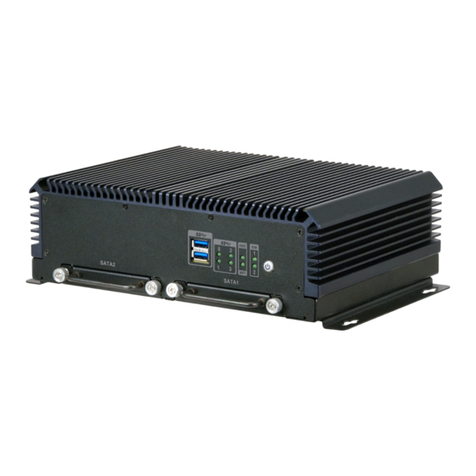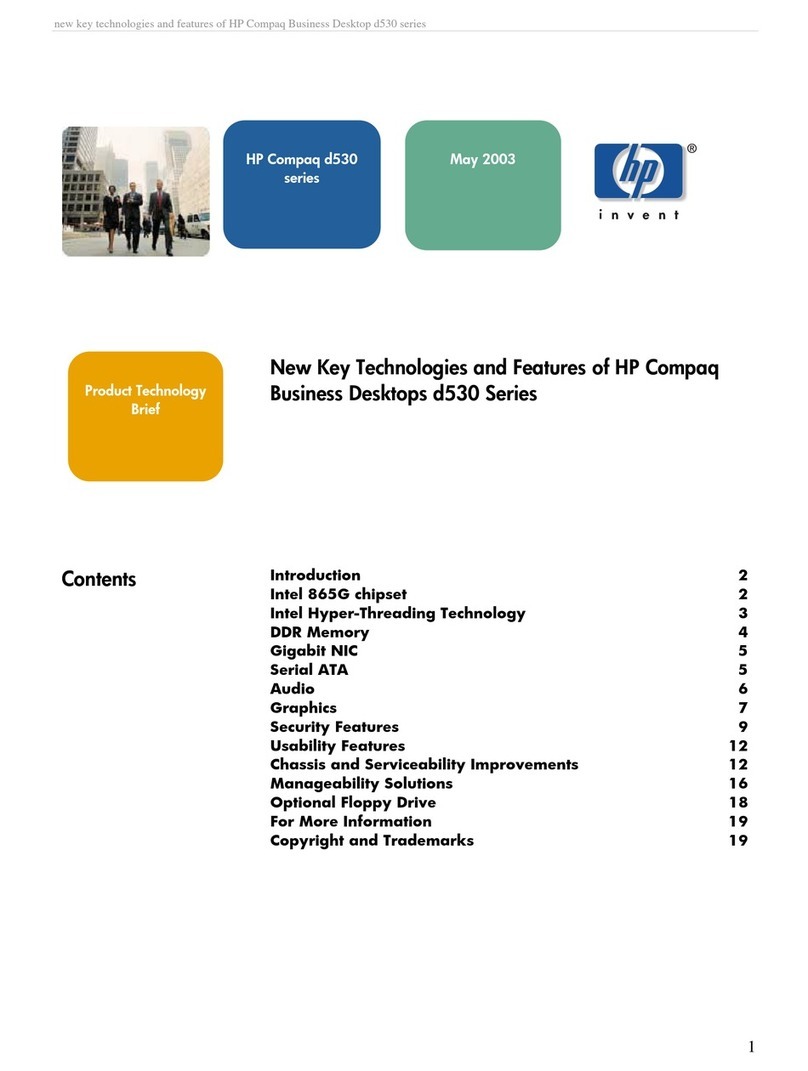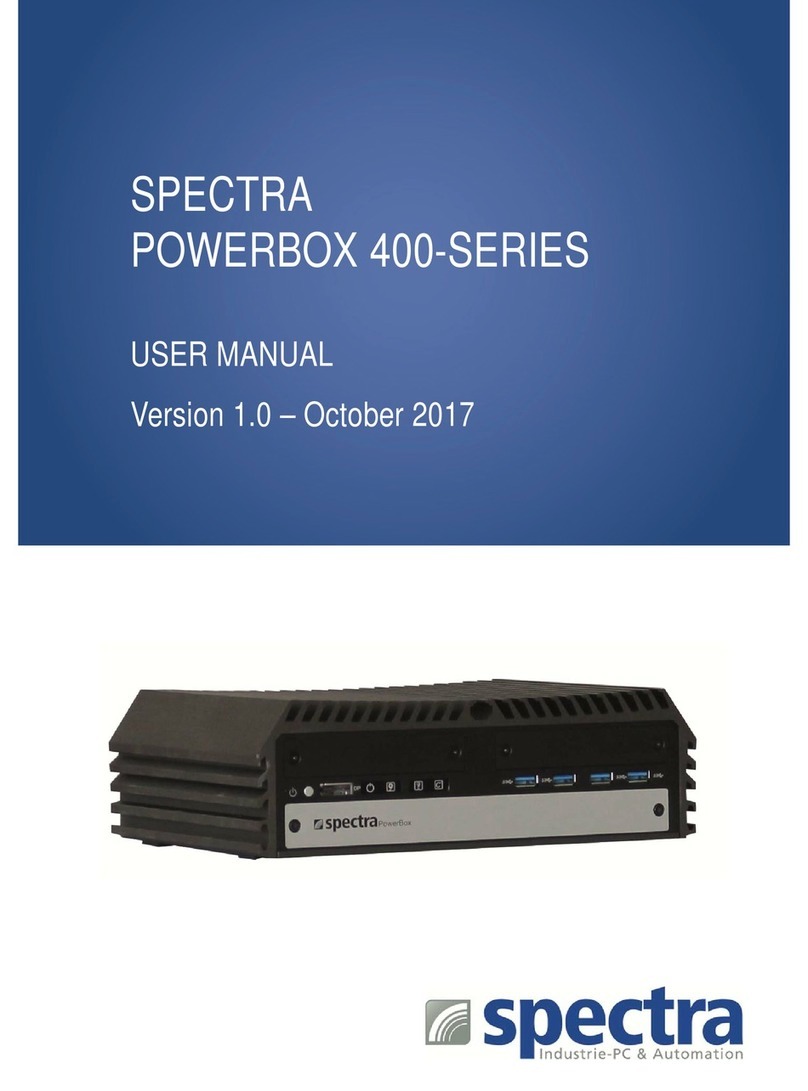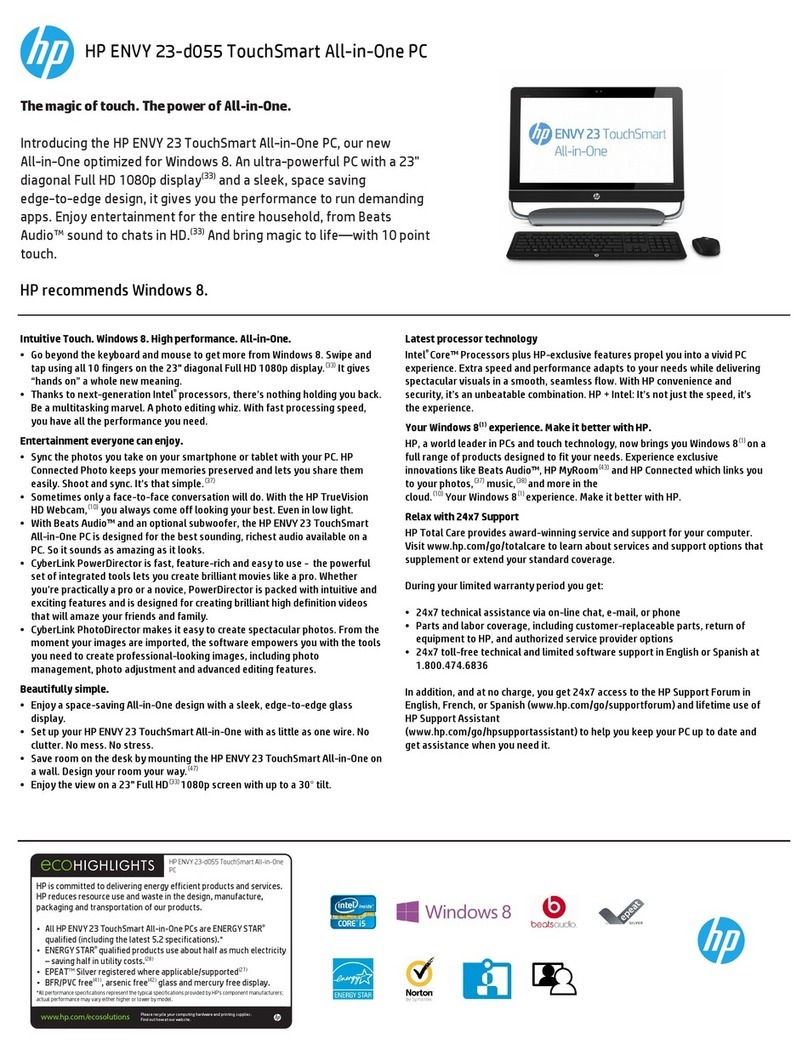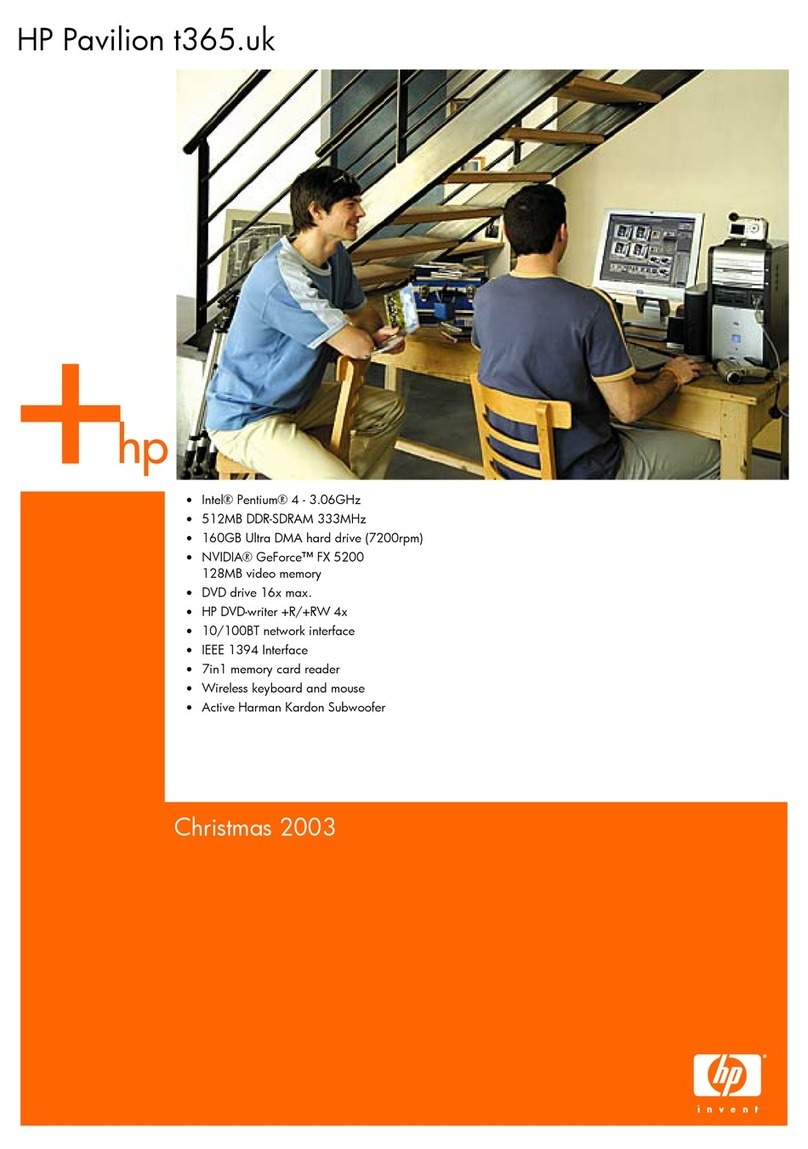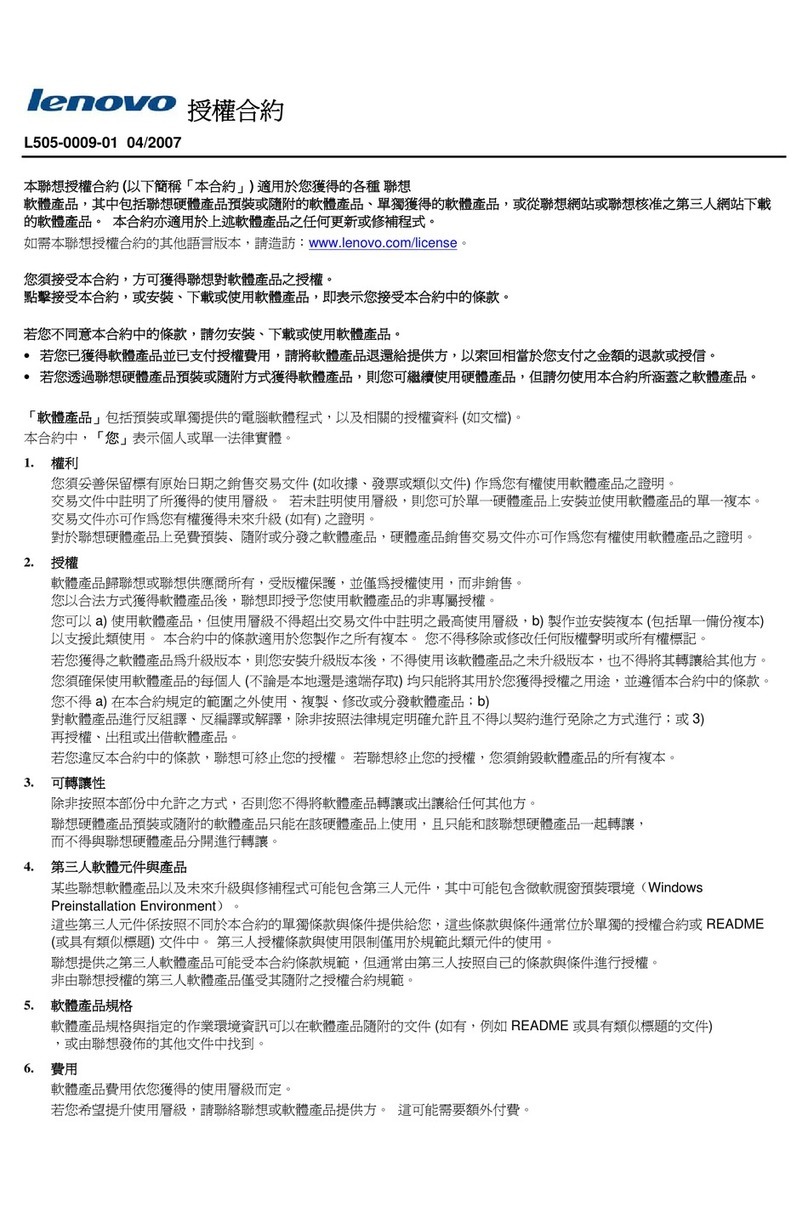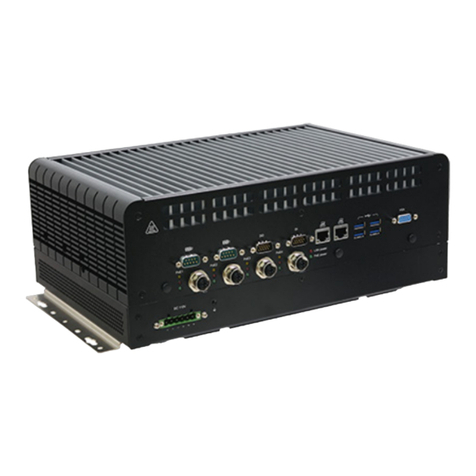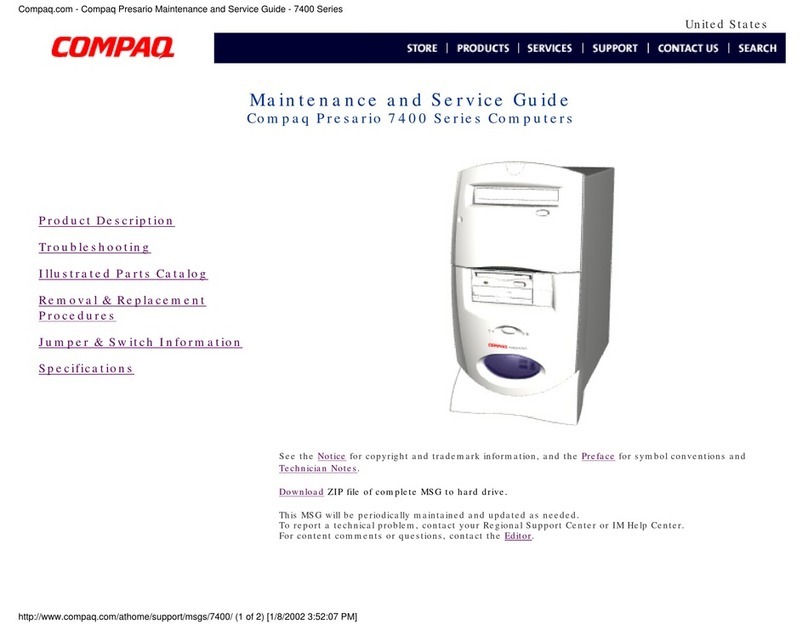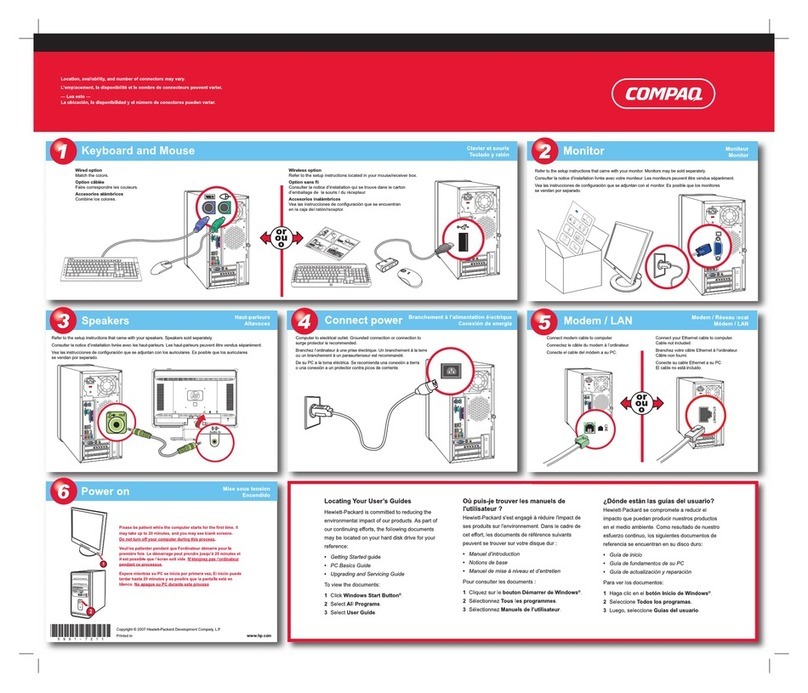Zenith H-100 User manual

..................
.........
.....
,
...
...................
:-
..
:-:-:-:-:-:-:
..
..
.........
:
H/Z-IOO
COMPUTER
SERVICE
DATA
MANUALj
ADDITIONAL
AND
UPDATE
MATERIAL
DIRECTIONS:
REPLACE the following pages with the accompanying
updated pages:
Pages 3-21 through 3-28,
Pages 3-67/3-68,
Pages 3-141 through 3-144,
First
two
pages
in
Section 5, Disk
Controller
and
Drives.
ADD
Part
II
to Section 5. This
is
new
data
for
the
H-207
Floppy Disk
Controller
Board.
CHANGE
the following:
Page
2-99,
Parts
Required,
Part
number
of
the
programming
plug
...
from:
HE
969-18
to:
HE
432-1168.
Page
3-159, Connectors
and
Sockets,
Part
number
of
the
4-pin
right-angle
connector
...
from:
HE
432-363 to
HE
434-363.
UPDATE
the Motherboard schematics
(refer
to the enclosed
schematic
revision
sheet)
.
10/82
,.
::::}U:U~
..................
/


INITIAL
SETUP
INTRODUCTION
The
H/Z-100
is
easy
to
disassemble;
even
an
all-in-one
unit
requires
only
about
15
minutes
to
remove
the
motherboard.
However,
due
to
the
way
the
unit
is
packaged,
there
are
very
few
test
points
that
you
can
reach
while
the
unit
is
assembled
and
operating.
To
get
around
this,
you
should
build
the
following
extender
cables.
These
extender
cables
allow
you
to
spread
out
the
H/Z-100
over
a
29"
x46"
surface.
This
permits
you
to
easily
reach
every
Ie
while
the
unit
is
operating.
PARTS
REQUIRED
2-99
10-82
Qty.
2
1
4
20
ft.
20
1
2
1
Description
40-pin
ribbon
cable
w/connectors
34-pin
ribbon
cable
w/connectors
Small
alligator
clips
for
jumper
wire
construction
#18
stranded
wire
Large
spring
connector
10-pin
adapter
plug
10-hole
socket
shell
Programming
plug
Part
No.
HE
134-1108
HE
134-1025
HE
260-16
HE
344-155
HE
432-753
HE
432-788
HE
432-1061
HE-432-1168


10-82
TEST,
Pin
23
Test
Input:
This
input
is
examined
by-t"ti'e"wait-for
test"
software
instruction.
If
pin
23
is
low,
execution
continues,
otherwise
the
processor
waits
in
an
idle
state.
MN/MX,
Pin
33
Minimum/Maximum:
Logic
one
on
this
pi
n
pl
ac
es
the
8088
in
the
minimun
mode,
the
mode
used
by
the
H/Z-100.
When
placed
in
the
maximum
mode,
some
of
the
pin
functions
change.
Usually,
the
maximlDll
mode
1s
used
for
larger
systems
and
multi-processing
systems.
RESET,
Pin
21
Reset:
Goes
high
to
reset
the
8088.
The
interrupts
are
disabled,
certain
registers
in
the
8088
are
set
or
cleared,
and
the
instruction
pointer
(program
counter)
points
to
the
memory
address
16
bytes
below
the
top
end
of
the
1
megabyte
range
(FFFFOH).
This
line
is
asserted
when
the
RESET
line
at
U236-11
is
pull
ed
low.
A
Sc
hm
it
t
tr
igger
shape
s
this
signal
and
the
clock
circuits
retimes
it
before
applying
it
to
the
8088.
READY,
Pin
22
Ready:
This
is
an
acknowledgement
signal
from
the
addressed
memory
or
I/O
port
that
it
is
ready
to
transfer
data.
When
this
line
is
low,
the
CPU
goes
into
a
wait
state
until
the
addressed
device
brings
it
high.
This
allows
using
the
8088
with
slow
memory
or
I/O
dev
ices.
The
READY
signal
is
generated
when
U205-9
places
a
logic
one
on
U236-4.
U236
synchronizes
this
signal
with
the
8088
clock
to
ensure
correct
set
up
and
hold
times.
eLK,
Pin
19
8088
Clock
Input.
Five-megahertz
clock
to
provide
timing
to
the
8088.
This
signal
comes
from
U236-8
which
derives
it
from
the
15-MHz
crystal
at
Y103.
Duty
cycle
is
about
33i
for
optimized
timing
inside
the
8088.
When
the
8088
is
the
active
processor,
this
line
also
goes
to
the
processor
swap
port
as
886
to
provide
system
timing.
3-21

3-22
IML
51lL
Sllf~IHT
ISWAP
PORTI
"'01""*-+"'l
LIIl4Cll.O
"'-h;,q-~"
P
+--tt!.)~A:-;-L';.;;JT;--tI!P
•
""'04.
~---,P--st
D
11
H
~-----'~~,....,U.,.,2~OJ
lS'"
44J''''
......
-----------=
....
'<.ItI-L-D._('7'(I
MOL'·
1111.
••
\.
........
+-F~
r--------------------------:~
.......
~----~II.I>
..
IlEF·
IW"
PROCESSOR
SWAP
PORT
(MBl)

10-82
PROCESSOR
SWAP
PORT
OVERVIEW
The
processor
swap
port
controls
which
CPU
is
to
be
active,
handles
interrupt
routing,
and
ensures
proper
timing
of
the
clock
circuits
during
the
swap.
To
access
the
swap
port,
the
CPU
writes
a
control
byte
to
port
OFEH.
Only
three
bits
of
the
byte
are
used:
ADO
controls
the
interrupt
mask,
ADl
controls
the
swap
interrupt
line,
and
AD7
performs
the
processor
swap.
PROCESSOR
SWAP
Refer
to
schematic
MBl
as
you
read
the
following.
At
power
up,
the
reset
circuits
clear
U171-9
to
logic
zero.
This
pin,
8SEL,
connects
to
U186-5,
a12H6
PAL.
This
IC
responds
by
placing
a
logic
zero
on
U181-12
and
a
l~c
one
on
U181-2.
On
the
first
positive
transition
of
85~,
the
85HOLD
line
will
go
low,
enabling
the
8085
CPU.
On
the
first
positive
transition
of
~,
the
88HOLD
line
will
go
high,
disabling
the
8088
cpu.
The
8085,
while
executing
the
code
in
the
monitor
ROM,
soon
transfers
control
to
the
8088.
It
does
this
by
setting
bit
7
of
the
processor
swap
port
control
byte
to
logic
one.
Here's
how
.•.
The
CPU
addresses
port
OFEH
to
assert
SWAPCS
(from
the
1/0
decoder)
at
U206-5.
It
then
sets
AD7
to
logic
one
at
U111-12.
Finally,
it
asserts
the
write
line
at
U206-6.
As
a
result,
Ul11-11
goes
high
and
latches
U171-9
to
logic
one.
The
8SEL
line
is
now
asserted.
The
values
at
U172-12
and U172-2
are
also
latched
to
their
respective
outputs,
but
these
will
be
covered
later.
3-23

3-24
The
8SEL
line.
now
logic
one.
causes
U186-13
to
change
to
logic
one.
U186-18
to
change
to
logic
zero.
and
U186-16
to
change
to
logic
one.
The
HOLD.
line
at
U185-11
asserts
whenever a
board
on
the
S-100
bus
takes
control
of
the
H/Z-100.
This
causes
U186
to
disable
both
the
8085
and
the
8088
through
U187. Both
CPUs
respond
by
returning
their
hold-acknowledge
signals;
the
8088
at
U186-3
and
the
8085
at
U171-2.
When
this
happens.
U186
asserts
the
HAK
line
at
pin
17.
This,
in
turn,
raises
the
S-100
pHLOA
line
to
logic
one
at
U180-9.
The
board
that
generated
the
HOLD·
request
can
now
take
control
of
the
H/Z-100.
SWAP
TIMING
The 88SEL
line
also
goes
to
U188-4,
a
quad
D-type
latch.
This
circuit
is
designed
to
suppress
any
glitches
on
the
system
clock
line
when
the
H/Z-100
switches
from one
CPU
to
the
other.
It
also
ensures
that
the
CPU
being
disabled
is
no
longer
active
when
the
other
CPU
is
enabled.
The
8085
and
the
8088
run
on
separate
crystal-controlled
clocks;
the
8085 from
Y101
and
the
8088 from Y103.
Although
these
clocks
are
stable.
they
aren't
in
phase.
Switching
from
one
clock
to
another
can
cause
a
glitch
on
the
system
clock
line,
S~.
which
can
upset
the
timing
in
other
circuits.

3-25
10-82
SWITCHING
FROM
8085
to
8088

3-26
To
see
how
U188 and
its
associated
circuits
block
this
spike,
refer
to
the
waveforms on
the
previous
page.
The two
top
waveforms
are
the
respective
clocks
for
the
8085
and
8088
CPUs.
These
are
present
at
the
inputs
of
inverters
U200-2
and
U200-14.
Assuming
that
the
8085
is
the
active
processor,
then
U200-1
is
low
and
85'
couples
through
the
inverter
to
form
Sl.
It
also
couples
through
U225B
to
clock
U188.
At
time
T1,
the
8088
is
selected;
the
88SEL
line
goes
to
logic
one
as
shown
at
A
on
the
waveforms
illustration.
The
next
clock
pulse
at
U188-9
latches
this
logic
one
into
U188-2,
the
Q1
output
at
B.
The
next
clock
pulse
causes
the
Q2
output
to
latch
high,
shown
at
C.
This
tri-states
U200
through
the
exclusive-DR
gate
at
U203B. At
the
same
time,
Q2
goes
low
to
couple
the
88~
clock
to
the
~
line.
Since,
in
this
example,
the
two
clocks
are
nearly
l80-degrees
out
of
phase,
the
clock
immediately
returns
to
zero,
causing
the
spike
at
D
in
the
waveforms
illustration.
Up
until
this
time,
the
output
of
U203-8,
another
exclusive-
OR
gate,
has
been
logic
one.
This
is
because
its
inputs
Q2
and
Q3
of
U188
have
been
in
opposite
states.
However,
since
Q2
went
low
at
time
T3,
both
inputs
to
U203C
are
the
same,
causing
U203-8
to
go
to
logic
zero
(waveform
E).
This
forces
the
system
clock
output
at
U225-3
to
logic
one
until
time
T4
(waveform
F).

10-82
At
time
T4,
the
first
positive-going
edge
of
the
8088
clock
causes
the
01
output
of
U188
to
go
high.
This
opens
the
gate
at
U225A
to
pass
the
system
clock,
which
is
now
the
8088
signal.
As
mentioned
earlier,
the
other
function
that
88SEL
and
U188
perform
is
to
ensure
that
the
CPU
being
disabled
is
completely
disabled
before
the
other
CPU
is
activated.
To
see
how
this
is
done,
again
refer
to
the
waveforms
illustration.
Once
again,
assume
that
the
H/Z-100
is
switching
from
the
8085
to
the
8088.
At
time
T
1,
the
88SEL
line
goes
high,
which
is
coupled
to
U203-11.
The
other
input
of
this
exclusive-OR
gate
is
the
Q2
line
from
U188.
Since
both
inputs
are
now
the
same
state,
U203-11
goes
to
logic
zero
to
preset
both
HOLD
latches
at
U187.
Both
CPUs
respond
by
going
into
a
HOLD
stat~
and
sending
hold-acknowledge
signals
to
U186;
the
8088
to
pin
3
and
the
8085
to
pin
4
through
U171.
This
asserts
HAK
at
pin
17
which
drives
the
S-100
pHLDA
line
at
U180-9.
At
time
T3,
the
Q2
line
goes
low
and
U203-11
returns
to
logic
one,
thus
releasing
the
latches
at
U187
from
their
preset
states.
The
next
88l
clock
pulse
latches
the
logic
zero
at
U187-2
into
U187-5,
removing
the
8088
from
the
hold
state.
Al
so
at
thi
s
time,
U
188-7
goes
high
to
drive
U215-3
high.
This
last
IC
connects
to
pin
21
of
the
S-100
bus
to
form
the
NDEF
(8088)
line.
This
line
is
a
"not-to-be-defined"
line
that
can
be
used
for
any
function
by
the
computer
manufacturer.
For
the
H/Z-100,
this
line
asserts
when
the
8088
is
active.
3-27

3-28
INTERRUPT
MASK
The
interrupt
mask
circuits
ensure
that
interrupt
requests
are
sent
to
the
currently
active
CPU.
The mask
bit.
MSK.
is
set
or
cleared
by
setting
or
clearing
bit
0
of
the
processor
swap
port.
If
set.
and
the
8085
is
active,
the
8085
gets
all
interrupt
requests.
If
cleared.
and
the
8085
is
ac
t i
ve.
the
in
terrupt
request
is
blocked.
However.
the
swap
port
will
disable
the
8085
and
enable
the
8088.
If
the
8088
is
active.
all
interrupt
requests
are
sent
to
the
8088
regardless
of
the
mask
bit.
Here's
hoW
it's
done
.••
Immediately
after
reset.
the
8085
CPU
is
the
active
processor.
Control
lines
5SEL
at
U171-8 and
MSK
at
U112-6
are
logic
one.
These
two
lines
connect
to
U225-9 and
U225-1
O.
shown
near
the
8085
IC
on
the
schematic.
U220-2
inverts
the
resulting
logic
zero
to
enable
U189A
and
U189D.
So
all
interrupts
are
sent
to
the
8085;
maskable
through
U189A.
non-maskable
through
U189D.
The
8SEL
line.
which
is
the
complement
of
5SEL.
disables
U1898
and
U189C.
the
AND
gates
to
the
8088.
Later.
when
the
8085
hands
control
to
the
8088
CPU.
8SEL
will
go
high
and
5SEL
will
go low.
If.
while
the
8085
is
selected.
the
MSK
line
is
set
to
logic
zero.
U220-2
disables
U189A
and
U189D.
This
blocks
the
interrupt
request
from
both
the
8085 and
the
8088.
However.
if
an
interrupt
request
should
occur.
either
standard
or
NMI,
U156-6
will
go
high
to
assert
the
NMINT
line.
The
NMINT
line
connects
to
U155-9
in
the
processor
swap
port.
The
other
input
is
the
MSK
line
which
is
also
high.
As
a
result,
U155-8
goes
low
to
assert
the
8SEL
line.
The
H/Z-100 swaps
to
the
8088
processor
as
described
previously.
When
the
8088
CPU
is
active.
8SEL
is
high
to
enable
U1898
and
U189C. U189A
and
U189D
are
disabled
because
5SEL
is
logic
zero
at
U225-9.
So,
no
matter
what
the
setting
of
the
R:rK
bit
at
U?25-10.
all
interrupt
requests
will
be
routed
to
the
BOB8
processor.

MAP
SELECTING
Map
selecting
takes
place
at
pins
1and 15
of
U111.
These
two
lines,
MAPSELO
and
MAPSEL1,
also
go
to
U173-7
and
-8;
but
currently
are
not
used
by
this
IC.
Depending
on
the
logic
state
of
U111-1 and
U111-15,
plus
the
address
on
lines
BA12-BA15,
the
memory map
will
appear
to
be
in
one
of
the
four
configurations
shown
in
the
illustration:
Confisuration
11:
HAPSEL
1=0
HAPSELO
-=
0
This
is
the
default
confisuration,
memory
is
contiguous
from
0
to
192K.
Confisuration
12: HAPSELl =0
HAPSELO
=1
In
this
configuration,
the
first
48K
of
bank
zero
appears
to
be
swapped
with
the
first
48K
of
bank
1-
The
two
16K
areas
and
the
rest
of
RAH
are
unchanged.
This
configuration
may
be
used
for
HP/H
while
runfling
the
8085
CPU.
Configuration
13:
HAPSELl
=1
HAPSELO
=0
In
this
configuration,
the
first
48K
of
bank
zero
appears
to
be
swapped
with
the
first
48K
of
bank
2.
The
two
16K
areas
and
the
middle
64K
of
RAH
are
unchanged.
This
configuration
alay
also
be
used
for
HP/H
while
running
the
8085
CPU.
Confisuration
14: HAPSELl =1
HAPSELO
=1
In
this
configuration,
56K
in
bank
0
appears
to
be
swapped
with
5t>K
in
bank
1.
four
kilobyte
buffers
above
and
below
each
56K
area
remain
unchanged,
as
does
the
top
64K
bank.
This
configuration
would
permit
using
an
extended
BIOS when
running
CP/H-85.
3-67
Note
that,
in
all
cases,
the
memory
only
swapped
from
the
memory's
point
of
view.
addresses
the
swapped memory,
the
memory
map
asserts
a
different
RAS
line
than
it
normally
appears
to
be
When
the
CPU
decoder
merely
would.
10-82
For
example,
assume
that
the
H/Z-100
is
operating
in
Configuration
114.
If
the
CPU
should
write
to
the
byte
at
the
6K
location,
U111
would
assert
REN1
instead
of
RENO.
The
memory
at
the
70K
location
will
be
written
to.
Bear
in
mind,
however,
that
as
far
as
the
CPU
(and
the
programmer)
is
concerned,
the
byte
at
6K
was
wri
tten
to.
Address
lines
BA12-BA15
allow
the
memory map
decoder
to
keep
some
sections
of
memory
in
place--down
to
4K
increments.

A~
m>
I
21{>~
BA0
" p
U1Bl
14
P
LS'244
12
P ,
3 P
&P
P
/4.7
m>
p
111
r
~~7
19
/"
r.p!I_7:
~~'!'1
.'"3
HI1
-~
U159
1~
l-I
H •
(,1
...\4.1
101
..
7·1~·
n
P4
G2A
.13.
H
--------
~
G28
12
P
256'1.4
LS1H
I""
~
PROM
~d·'n
11
p1A
1""1'
H
BA~.
U179
5A1
P,BV
t!.
82.~129
P5
Af
~
12./ P
p.
3c
I""
p
BA2
-
1/
P,
~
,..,
..
P1'1 P
P4
'"
H
10
0
E:C
4/
P
.3
_1(21/
PP1
...
U157
Gl
5p
P
2.
I"'"
P2A,/P
P,
.q/
P
PJ
!>
03
7p
P
1~
A"7
..,-
~~'39
~2/
~
"lolll4·1JI
P,s.
"43";U-
,..,
C[1
CE2
G2
11/
H_
_
iJ
~'4
Pl~
A
,_/
p-
P
13
~
10
BA3
8
...
q
~
I
I/O
PORT
DECODER
r
T~RSTATCS
MEMCTRl,.CS
l"I1·ADCS
~WAPCS
D5~5EL
!Z39AC.~
~2S9AC.S'"
KEY8DSH
,"~ZIC5
8,5~CS
EPCl ACS
EPCl BCS
810SEL
w
I
Cl'l
CD
I/O
PORT
DECODER
CMB2)

PROCESSOR
SWAP
TESTS
SWAP
TEST
#1
1.
Lift
pin
5
of
U186
(MS1).
2.
Jumper U186-5
to
ground.
3.
Apply power and
perform
the
following
steps:
3-141
CHECK
·S100-21
=L
·U180-9 =L
·U186-3 =H
·U186-4 =L
(MS1)
(MS1)
(MS1)
(MS1)
IF
NOT
OKAY,
CHECK
U215-3
UlaO-l0
U2l1-30
U17l-5
10-82
Go
to
Swap
Test
#2
U17l-l
::
L
(MS1)
U2l0-38
U171-5 =L
(MS1)
U171-1
U180-10
::
L
(MS1)
U186-17
U186-3 =H
(MS1)
U2ll-30
U186-4
::
L
(MS
1) U171-5
U186-l6 =L
(MS
1) U186-3
U186-17 =L
(MS1)
U186-4
U186-l8 =H
(MS1)
U186
is
defective.
U187-2
::
H
(MS1)
U186-l8
U187-3 =p
(MS1)
Restore
U186-5 and go
to
CLOCK
CIRCUITS
TESTS.
U187-5 =H
(MB
1) U187-2. U187-3
U187-9 =L
(MS
1) U187-10,
U187-ll,
U187-12
U187-l0
::
H
(MS1)
U203-l1
U187-ll
::
P
(MS1)
Restore
U186-5 and go
to
CLOCK
CIRCUITS
TESTS.
U187-l2 =L
(MS1)
U186-3
U203-1l
::
H
(MS1)
U203-l2,
U203-l3
U203-12
::
L
(MS1)
U186-l6
U203-13
::
H
(MS
1)
Restore
U186-5 and go
to
CLOCK
CIRCUITS
TESTS.

3-142
U210-38 =L
(MB1)
U210-39
U210-39 =L
(MS
1) U187-9
U211-30 =H
(MS1)
U211-31
U211-31 =H
(MS1)
U187-5
U215-2 =L
(MS
1)
Restore
U186-5
and
go
to
CLOCK
CIRCUITS
TESTS.
U215-3 =L
(MS
1)
U215-2
-----------------------------------------------------------------------
-----------------------------------------------------------------------
SWAP
TEST
#2
1.
Lift
pins
4and 5
of
U186.
2.
Jumper U186-4 and U186-5
to
5
volts.
3.
Apply power and
perform
the
following
tests:
CHECK
.S
100-21 =H
·U
171-5 =H
·U180-9 =L
(MS1)
(MS1)
(MS1)
IF
NOT
OKAY,
CHECK
U215-3
U171-3, U171-2, U171-1
U180-10
Go
to
Swap
Test
#3.
U171-1 =H
U171-2 =H
U171-3 =p
(MS1)
(MSl
)
(MS1)
U210-38
U210-38
Restore
U186-4 and U186-5
and go
to
CLOCK
CIRCUITS
TESTS.
U180-10 =L
(MS1)
U186-3 =L
(MS
1)
U186-13 =H
(MS
1)
U186-16 =H
(MS1)
U186-17 =L
(MS
1)
U186-18 =L
(MS1)
U186-17
U211-30
U186-3
U186-3
U186-3
U186
is
defective.

U187-2 =L
(MB1)
U186-18
U187-3 =p
(MB1)
Restore
U186-4 and U186-5
and go
to
CLOCK
CIRCUITS
TESTS.
U187-4 =H
(MB1)
U203-11
U187-5 =L
(MB1
)U187-2_ U187-3_ U187-4
U187-9 =H
(MB1)
U187-11_ U187-12
U187-11 =P
(MB1)
Restore
U186-4 and U186-5
and go
to
CLOCK
CIRCUITS
TESTS.
U187-12 =H
(MB1
)U186-13
U203-11 =H
(MB1)
U203-13_ U203-12
U203-12 =H
(MB1)
U186-16
U203-13 =L
(MB1)
Restore
U186-4 and U186-5
and go
to
CLOCK
CIRCUITS
TESTS.
U210-38 =H
(MB1)
U210-39
U210-39 =H
(MB1)
U181-9
U211-30 =L
(MB1)
U211-31
U211-31 =L
(MB1)
U187-5
U215-2 =H
(MB1
)
Restore
U186-4 and U186-5
and go
to
CLOCK
CIRCUITS
TESTS.
U215-3 =L
(MB1)
U215-2
======================================================================
SWAP
TEST
#3
3-143
1.
Restore
pin
4
of
U186;
leave
pin
5
lifted.
2.
Jumper U186-5
to
ground.
3.
Turn on
the
H/Z-100.
4.
Connect
ajumper
wire
from ground
to
pin
74
of
the
S-100
bus (HOLD·).
5.
Perform
the
following
tests:
..
CHECK
·U180-9
=H
(MB
1)
IF
NOT
OKAY_
CHECK
U180-10
10-82
Go
to
Swap
Test
#4.

3-144
U180-10 =H
U186-13 =H
U186-16 =H
U
186-17
=H
(MB1)
(MB1)
(MBl
)
(MB1)
U186-17
U186
is
defective.
t
U186
is
defective.t
U186-13. U186-18
tNOTE:
Before
replacing
U186.
check
the
continuity
between
pins
6and
15.
and
between
pins
7and
14.
Also
check
for
ground
at
pins
2.
8.
9.
10.
11. 12. and
19.
===============;======================================================
SWAP
TEST
#4
1.
Remove
the
jumper
between
ground
and
pin
5.
2.
Connect
the
jumper from
pin
5
to
+5
volts.
CHECK
.U180-9
=H
End
of
tests.
U180-10 =H
U186-13 =H
U
186-17
=H
U186-18 =H
(MB1)
(MB1)
(MB1)
(MB1)
(MB1)
IF
NOT
OKAY.
CHECK
U180-10
U180-17
U186
is
defective.
t
U186-13. U186-18
U186
is
defective.
t
tNOTE.
Before
replacing
U186.
check
the
continuity
between
pins
6and
15,
and
between
pins
7and
14.
Also
check
for
ground
at
pins
2.
8,
9,
10. 11,
12,
and
19.

PARTS
LIST
C!
?CJ
1
~,
..
~~
:':5:':
:Tl~'i
HEATH
Part
';0.
c:
;lCe
IT
Com?
~Io.
DESCRIP710:/
HEAT"
Part
:/0.
CIRCUIT
Compo
~O.
OESCRl?i!C~
HEl,iH
Part
No.
INTEGRATED
CIRCUITS
(CONTINUED)
I
INTEGRATED
CIRCUITS
(CONTINUED)
I
CRYSTALS
YI01
10.000
MHz
crystal
HE
404-645
U
170
74ALS1020
HE
443-1081
U210
8085A
HE
443-1010
YI02
6.000
MHz
crystal
HE
404-647
U171
74ALS74
HE
443-1051
U211
8088
HE
443-1009
Y103
15.000
MHz
crystal
HE
404-644
U172
7"ALS74
HE
443-1051
U212
74LS273
HE
443-805
UI73
HAL14L4
HE
444-130
U213
74LS373
HE
443-837
U174
74LS32
HE
443-875
U214
74LS244
HE
443-791
CONNECTORS
-
SOCKETS
U175
74L510
HE
443-797
U215
74L5125
HE
443-811
U176
74L5174
HE
443-879
U216
74ALS28
HE
443-1048
8-pin
IC
socket
HE
434-230
U
177
74LS240
HE
443-754
U217
74LS244
HE
443-791 14-pin
IC
socket
HE
434-298
U178
74LS244
HE
443-791
U218
96LS02
HE
443-1040 16-pin
IC
socket
HE
434-299
U179
825129
PROM
HE
444-101
U219
74ALS74
HE
443-1051 18-pin
IC
socket
HE
434-310
20-pin
IC
socket
HE
434-311
U180
74LS367
HE
443-857
U220
74LS04
HE
443-755
24-pin
IC
socket
HE
434-307
U181
74LS244
HE
443-791
U221
74L532
HE
443-875 28-pin
IC
socket
HE
434-310
Ul82
74L514
HE
443-872
U222
74L500
HE
443-728 40-pin
IC
socket
HE
434-253
u183
7"LS02
HE
443-779
U223
74L5244
HE
443-791
2-pin
connector
HE
432-1171
U184
74LS156
HE
443-1036
U224
74ALS28
HE
443-1048
3-pin
connector
HE
432-1102
u185
74L514
HE
443-872
U225
74AL537
HE
443-1049
4-pin
right-angle
connector HE-434-363
U186
HA1.12H6
HE
444-128
U226
74S288'
PROM
HE
444-105
9-pin
right-angle
molex
HE
432-1202
U187
74ALS74
HE
443-1051
U227
74LS373
HE
443-837
U188
74LS175
HE
443-752
U228
781.12
.12V
regulator
HE
442-644 connector
10-pin connector
HE
432-903
U189
741.S08
HE
443-780
U229
791.12
-12V
regulator
HE
442-646
20-pin
connector
HE
432-1227
2764
ROI1
HE
444-87
U230
75189
HE
443-795
25-pin
Fright-angle
"0"
HE
432-1195
U190
connector
U191
4.000
HHz
oscillator
HE
150-132
U231
75452
HE
443-74
25-pin
H
right-angle
"0"
HE
432-1194
U192
74L5169
HE
443-1054
U232
555
timer
HE
442-53 connector
U193
'!4U367
HE
443-857
U233
74ALS74
HE
443-1051
40-pin
connector
HE
432-1062
U194
7417
HE
443-72
U234
74ALS74
HE
443-1051 Jumper
HE
432-1041
U195
74L5240
HE
443-754
U235
74ALS10
HE
443-1047
S-10D
board edge connector
HE
432-1193
U196
74L5373
HE
443-837
U236
8284A
HE
443-1011
U197
741.Sfl3
HE
443-837
U237
74LS125
HE
443-811
U198
74LS373
HE
443-837
U238
74ALS74
HE
443-1051
HARDWARE
U199
741.S156
HE
443-1036
U239
74LS244
HE
443-791
14
lockwasher
HE
254-9
U200
74LS368
HE
443-1024
U240
4.9152
MHz
oscillator
HE
150-133
14
nut
HE
252-15
U201
74L5125
HE
443-811 U24'
74L5244
HE
443-791 4-40 x
5/16"
hex
"0"
spacer
HE
255-757
U202
74A1.S74
HE
443-1051
U242
2661-2
HE
443-1061 4-40 x
5/16"
black
HE
250-1469
U203
74LS86
HE
443-891
U243
2661-2
HE
443-1061
phillips-head
screw
U204
8741A
HE
444-141
U244
74LS244
HE
443-791
U205
74S74
HE
443-900
U245
75188
HE
443-794
U206
74ALS02
HE
443-1045
U246
75189
HE
443-795 I
HISCELLANEOUS
U207
74LS14
HE
443-872
U247
75189
HE
443-795
HE
85-2653-1
U208
8259A
HE
443-1012
U248
75188
HE
443-794
PC
board
U209
825~A
HE
443-1012 Wire. bare
HE
340-8
Wire, blue wirewrap
HE
344-189
0101
IN5817
diode
HE
57-507
0102
IN4149
diode
HE
56-56
0103
1N4149
diode
HE
56-56
0104
1N4149
diode
HE
56-56
SW101
8-section
slide
switch
HE
60-621
Xl01
Audio
transducer
HE
473-29
- -
.......
0I I w
II
CO
t-'
NlJ1
\.0

This manual suits for next models
1
Table of contents
Other Zenith Desktop manuals

Zenith
Zenith Z-100 Series User manual
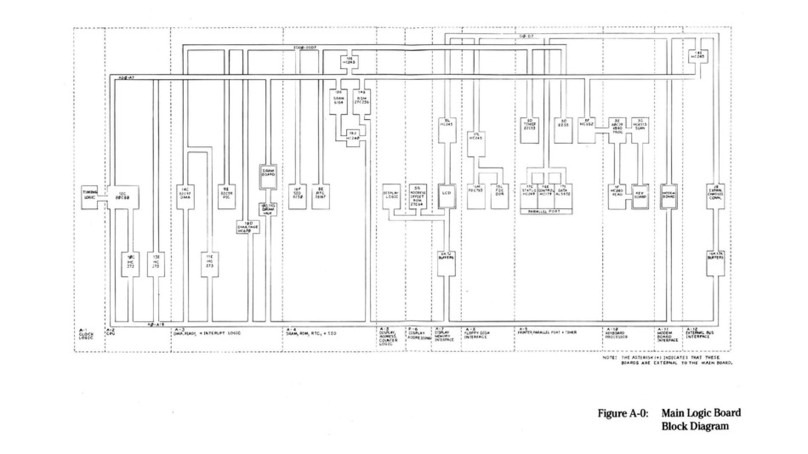
Zenith
Zenith Z-171 Service manual

Zenith
Zenith Z-100 Series User manual

Zenith
Zenith Z-171 User manual

Zenith
Zenith Z-150 User manual
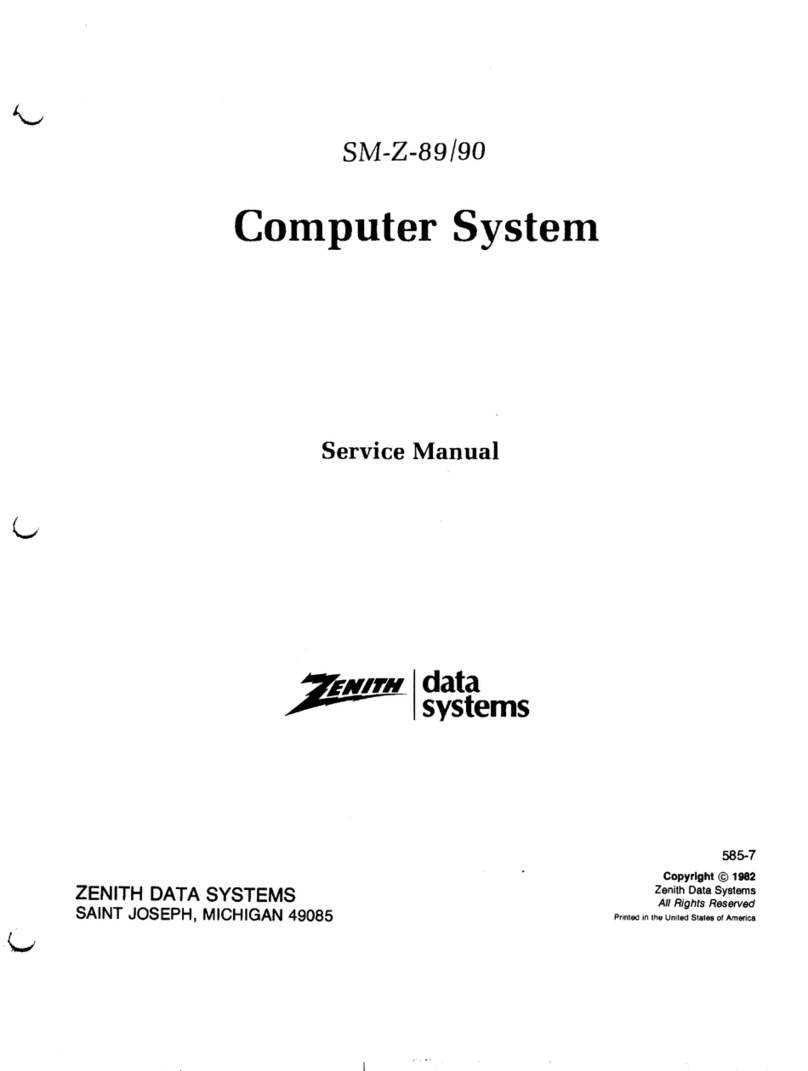
Zenith
Zenith SM-Z-89 User manual

Zenith
Zenith Z-200 series User manual
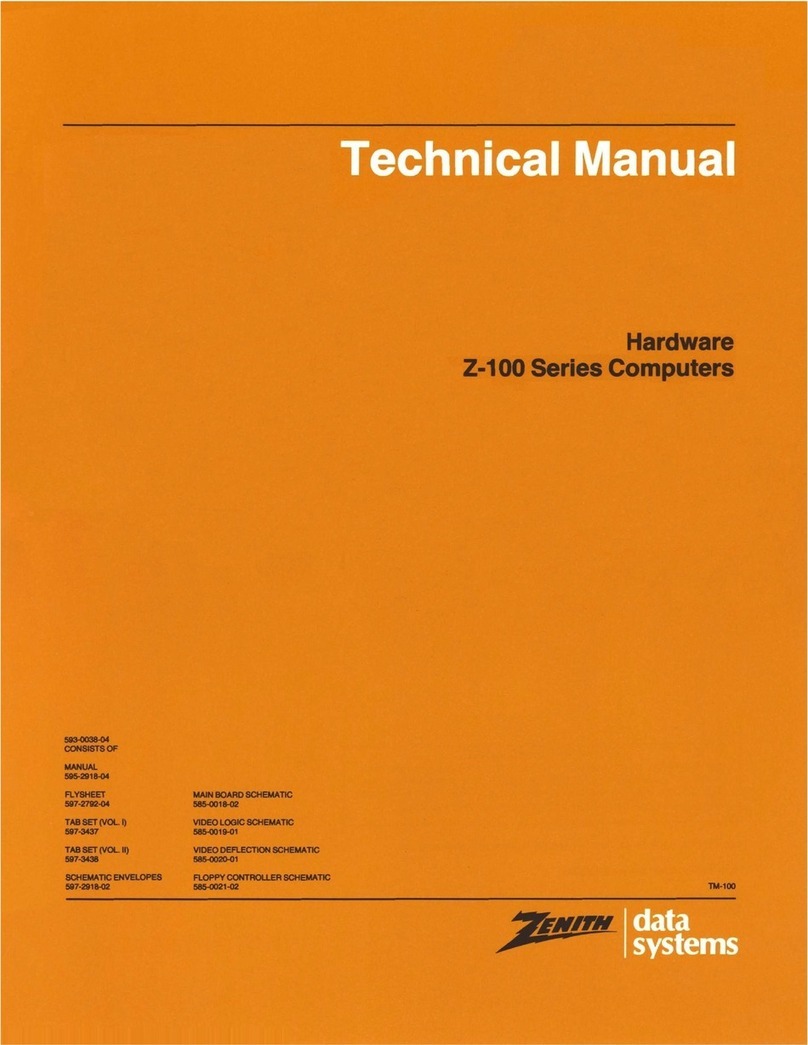
Zenith
Zenith Z-100 Series User manual
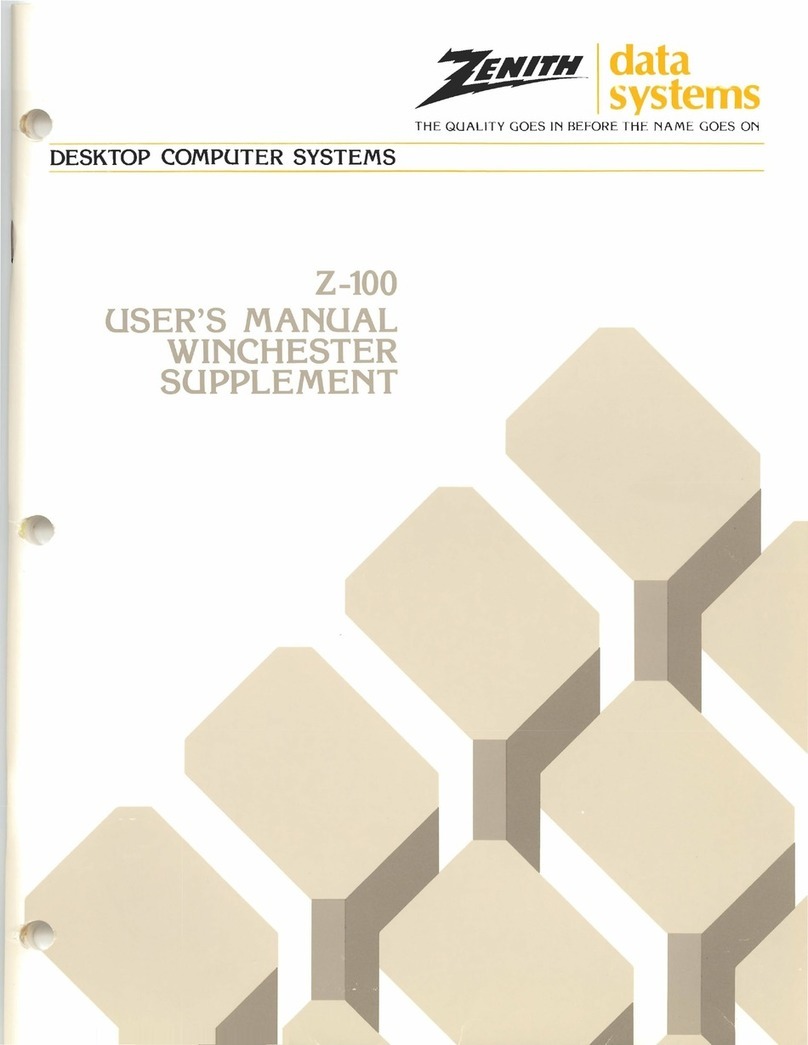
Zenith
Zenith Z-100 Series User manual
